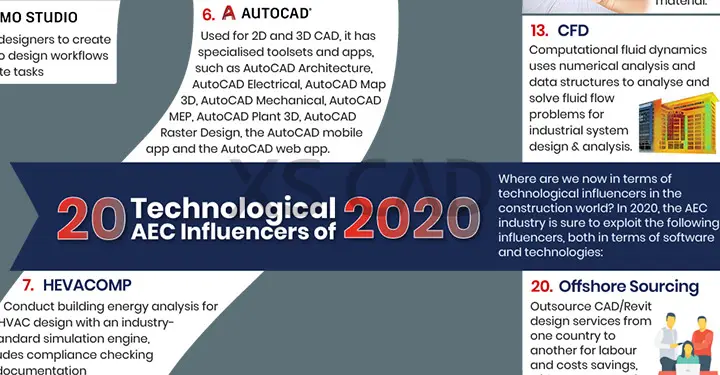Our Articles

20 Technological AEC Influencers of 2020
Where are we now in terms of technological influencers in the construction world? In 2020, the AEC industry is sure to exploit the following influencers, both in terms of software and technologies:

1. Dynamo Studio – platform for designers to create visual logic to design workflows and automate tasks
2. Revit – powerful tools designed for BIM (Building Information Modelling) are used to plan, design, construct and manage buildings.
3. Navisworks Manage – reviews projects with 5D analysis and design simulation
4. Fabrication CADMEP – used for MEP detailing and documentation
5. AutoCAD – used for 2D and 3D CAD, it has specialised toolsets and apps, such as AutoCAD Architecture, AutoCAD Electrical, AutoCAD Map 3D, AutoCAD Mechanical, AutoCAD MEP, AutoCAD Plant 3D, AutoCAD Raster Design, the AutoCAD mobile app and the AutoCAD web app
6. 3Ds Max – used for visualisation and animation, it is a 3D modelling and rendering software
7. Autodesk Rendering – helps develop fast, high-resolution renderings in the cloud
8. Advance Steel – helps steel detailing with 3D modelling, then Robot Structural Analysis Professional can use the advanced BIM-integrated structural analysis and code compliance verification tool
9. Autodesk Drive – CAD-aware cloud storage for teams
10. FormIt Pro – 3D sketching app with Revit interoperability
11. InfraWorks – BIM platform for planning, design and analysis
12. Insight – building performance analysis software
13. ReCap Pro – reality capture and 3D scanning
14. CFD – Computational fluid dynamics uses numerical analysis and data structures to analyse and solve fluid flow problems for industrial system design and analysis.
15. AR – Digital assets can be placed on existing spaces, showing how designs appear realistically – such as a new interior wall or new flooring material
16. VR – Virtual spaces are created to show form, space and allow people to walk through realistic environments. Architects and engineers can see any flaws or potential risks. Revit Live – helps transform Revit models into immersive experiences with just one click
17. Robotics – Construction robots are expected to improve working conditions, help avoid accidents and increase productivity.
18. Green building – Structures created and processes used are environmentally responsible and resource-efficient from siting, design, construction, operation, maintenance to renovation
19. IoT – Machines constantly position and complete projects efficiently. Data gathered helps assess material delivery and installation, location of workers, monitor temperatures, noise, smoke, dust and thus prevent property damage, freezing of parts, product failures, pressure loss, fires and water leaks.
20. Cloud Computing – Graphic programmes, animation, rendering files, photographs in high resolution, field conditions, work in progress and completed work contribute to the growing data storage needs. Through cloud, all the data can be accessed from one source.
In addition to the 20 advances included here, many new ones are expected in 2020.

